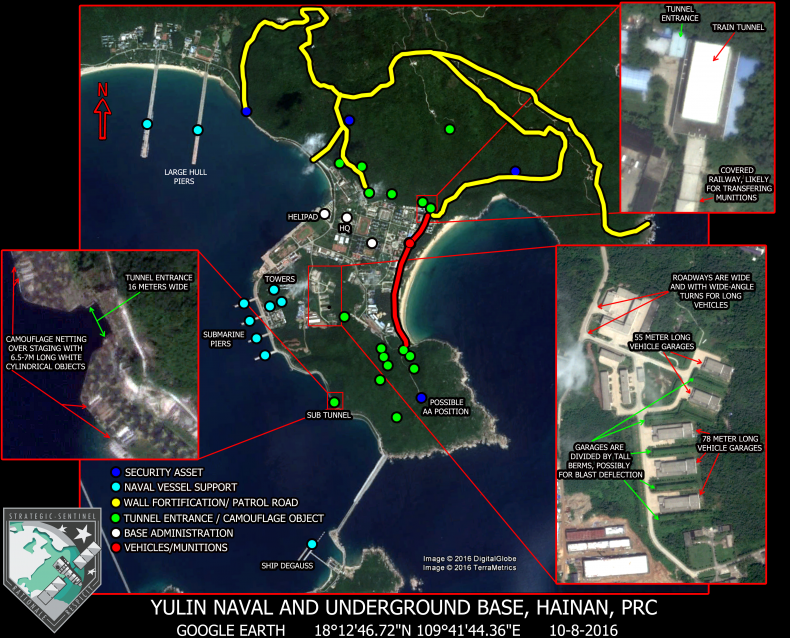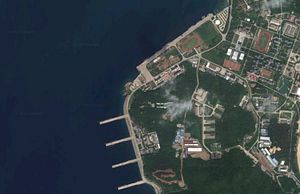Near the picturesque city of Sanya, at the southernmost tip of Hainan Island, the Chinese People’s Liberation Army Navy is methodically preparing itself for the next phase of power projection in the South China Sea. The site in question is the Yulin Naval Base, and it is shaping up to be the most strategically important military base in the South China Sea. In fact, it may already hold the title, depending largely on the current nuclear submarine traffic flowing in and out of Yulin’s underground facility. Theater and point defense assets have been deployed, degaussing and weapons-loading facilities appear operationally ready — as do the administrative buildings, munitions transportation systems, and geological fortifications — and much of the South Sea Fleet’s submarine force has already nestled itself deep into the resident mountain. With a healthy mix of surface vessels, anti-aircraft and anti-ship missile platforms, and both conventional attack and nuclear deterrent submarines, Yulin’s strategic value is steadily rising. And with it rises China’s coercive power in the South China Sea and its surrounding waterways.
Yulin-East [1]
Open-source intelligence tools provide an informative glimpse of Hainan Island’s busy, fortified, and increasingly vital base. All told, Yulin-East encompasses over 25 square kilometers (sq km) of military infrastructure lying within a protected, man-made harbor. As will be expanded on below, the base accommodates surface and subsurface vessels (and most of the necessary accouterments thereof), theater and point defense weapons systems, munitions transport vehicles and depots, and administrative buildings for military commanders.

Construction began by the year 2000, and though it is not yet complete, the sprawling complex reflects all of its 17 years of dedicated effort. Yalong Bay’s natural defenses — namely, of course, the big imposing mountain — must have caught China’s eye. The mountain itself now houses China’s sea-based nuclear deterrent, suitably sheltered under a few hundred feet of earth and stone. Still, prudently recognizing that geological advantages alone would not win the day, China constructed a large and formidable sea wall along the base’s border. Satellite photographs taken over the past 15 years tell a tale of gargantuan effort and expenditure. How these physical fortifications would fare against a coordinated wave of strikes from China’s adversaries is unclear.
In addition to its natural and man-made fortifications, Yulin-East boasts an array of theater and point defense technologies. At least five buildings at Yulin-East, each separated from one another by protective blast walls, are capable of housing Surface-to-Air Missile (SAM) batteries. The variations in length — two weapons storage buildings measure 55 meters while three measure 78 meters — could indicate planned installments of shorter- and longer-range SAMs to layer the base’s defenses. Rounding out the team are anti-ship cruise missile (ASCM) launchers lining either side of the submarine tunnel entrance. Longer range models like the C-802 and YJ-83 are too long for the 6.5-7m canisters identified by Strategic Sentinel. The C-801, a lighter weapon designed to defend a smaller area, would be a better fit. The anti-aircraft and anti-ship missile platforms on China’s artificial islands project their military’s power over important waterways; the similar but distinct systems stationed at Yulin-East primarily defend the base itself.
Yulin-East’s highest value assets are its submarines (and associated facilities), as will become abundantly clear. As seen in the attached graphic above, Yulin-East houses four submarine piers capable of docking any submarine in the PLA Navy — including the Shang-class attack submarine, two of which are docked in the image. Open-source satellite photographs have shown weapons loading occurring on these piers, but there remains much speculation about whether weapons loading also occurs inside the underground berthing facility. This would not be an ideal location, since an accidental concussive blast would be made exponentially more dangerous in such an enclosed space. (A sturdy enclosed space filled with expensive combustibles.) However, either in wartime or in an effort to preserve vital secrecy, China may accept this risk and load explosive weaponry inside the underground facility. Currently, not enough open-source documentation of submarine weapons loading at Yulin exists to account for all of what we would expect to see, leaving open the very distinct possibility that China has chosen to perform some of these activities in the underground berthing facility just inside the mountain.
The only entrance into the mountain’s underground berthing facility is a 16-meter-wide semi-submerged submarine tunnel entrance; this, as the Federation of American Scientists has previously noted, is 3 meters — or nearly 20 percent — wider than the entrance at the North Sea Fleet’s Jianggezhuang Naval Base. China plans to base all of its largest subs, the Jin-class (or Type 094), in this mountain. The Jin-class submarines are the only ship in the PLAN that carry nuclear missiles — up to 12 each— and are the start of China’s sea-based nuclear deterrent. Though China only plans to build six Jin-class subs, the minimum required to maintain a continuous naval second-strike capability, a new class of nuclear submarines will make an appearance in the coming decade. Yulin will soon be the headquarters to not just the South Sea Fleet’s submarine force, but to an entire leg of China’s nuclear triad.
Though Yulin-East’s most salient purpose is to house nuclear submarines, surface warships are far from excluded in its mission. Along the northernmost crook of Yalong Bay, two surface combatant piers stand ready to host virtually any surface ship in the PLAN. We estimate that these two piers, each nearly a kilometer in length, can house up to sixteen frigates total — or some similar combination of destroyers, corvettes, and frigates as necessary. At least one satellite image shows loading cranes preparing to service a docked surface vessel. Just a few kilometers west, the PLAN has also constructed piers capable of housing two aircraft carriers. (And they might, too, if China had even one aircraft carrier to spare.)
Strategic Analysis and Implications
Base Vulnerabilities and Defenses
Layered theater defense of Yulin-East is more than merely expected — it would be rather strange if such anti-aircraft and anti-ship assets were missing. The HQ-9 surface-to-air missile battery is the most likely deployment, for now. With assets as valuable as Yulin’s, the S-400s China is purchasing from Russia are also plausible future residents of the island. The S-400 has a better chance of causing trouble for the fifth generation planes that may target the base. However, the Russian SAM also boasts a much longer range than the HQ-9, and therefore would be more effective serving China’s A2/AD strategy on artificial islands deep in the South China Sea. Strategic Sentinel will keep a close watch on these facilities once the S-400s are delivered. Whether China values extending its area denial range more than increasing the effectiveness of Yulin’s theater defenses will presumably be demonstrated in due course. As noted in the above section, China has also positioned anti-ship cruise missiles near the submarine tunnel entrance. These are likely short-range missile launchers (as indicated by their size), and as such somewhat ineffective at deterring modern surface combatants, which could strike Yulin from well out of range.
Though Yulin’s point defenses pose a very manageable challenge to U.S. forces, Hainan Island itself is remarkably well defended. The environment is rich in electronic warfare assets and well within range of Chinese air bases and the J-11 aircraft housed there. The island’s security is very highly prioritized — in a private conversation, one analyst described the Chinese as “very sensitive about [Hainan].” So, although Yulin’s point defenses themselves are something short of awe-inspiring, the base is still sheltered by the heavy military presence nearby. Any U.S. attempt to strike targets on Hainan Island would only really be practicable in the context of a larger scale conflict and would require extraordinary effort. Successfully striking Yulin or other Hainan targets is definitely within the realm of U.S. capability, but would also undoubtedly be enormously expensive (in terms of logistical effort, hardware deployed and lost, lives lost, and of course a disturbingly vast sum of money).
Warships, Above and Below
Yulin serves as the perfect complement to China’s strategic goals in the South China Sea. Artificial islands throughout the Sea itself host A2/AD technology to deter or delay the United States from encroaching on China’s sphere of influence. The Jin-class nuclear missile submarines housed at Yulin deter the United States from attacking China with nuclear weapons — and from charging into any conflict, for that matter. And finally, Yulin’s many surface combatants, aircraft carriers, and attack submarines coerce regional navies into submitting to China’s aggressive maneuvers and acceding to its claims. Yulin’s dual mission — deterrence for the West and coercion for the rest, if you will — magnifies its strategic value.
Stocking Yulin with attack submarines and carrier strike groups facilitates a type of power projection tailored to the most relevant audience: rival South China Sea claimants. China uses its submarine force as an anti-surface warfare vessel, making it ideally suited to this mission of classical naval power projection. (Indeed, nearly a full two-thirds of China’s entire submarine force is armed specifically to sink enemy ships, rather than strike land targets or hunt other submarines.) When China deploys its future carrier strike groups from Yulin, it intends to remind rival claimants that China can strike their cities and knock their planes out of the sky. Until the PLAN’s new aircraft carriers arrive, simply sailing destroyers and frigates through Southeast Asian exclusive economic zones (EEZs) visibly demonstrates a strategic commitment to the nine-dash line. And when said surface ships are otherwise occupied, Chinese subs may make a point of surfacing just a few miles from an opposing navy, as they did with a U.S. aircraft carrier in 2006. The coercive pressure on Southeast Asian navies is palpable as the People’s Republic cements its de facto control over the South China Sea.
While the attack submarines and surface vessels exert pressure on regional navies, Yulin’s Jin-class submarines will be securing China’s second-strike capability. The Jin-class, capable of holding 12 intercontinental nuclear ballistic missiles at a time, constitutes the entire naval component of the Chinese nuclear triad. As second-strike guarantors, these subs will spend as little time inside the mountain as possible. And in the case of a conflict, it would most behoove China to disperse their nuclear submarines as widely as possible, keeping them far away from obvious targets like the Yulin base. Still, the mountain at Yulin provides a formidable shield when the subs are at their most vulnerable — that is, when they are being repaired, refueled, or possibly even upgraded.
Conclusions
Yulin-East, this growing naval complex jutting into the South China Sea, is establishing itself as one of the most vital military bases in the Asia-Pacific, and indeed the world. The base stands out for the missions it facilitates: classic, conventional power projection for the region and strategic nuclear deterrence for the globe. Yulin-East’s surface vessels and attack submarines will strengthen China’s position over important regional trade routes and attempt to coerce China’s neighbors into accepting the nine-dash line The Jin-class submarines, powerful guarantors of China’s second-strike capability, will be Yulin’s most valued yet least present asset. The South China Sea, already crowded by over a dozen navies, just got a lot smaller.
[1] “Yulin” serves as a term largely interchangeable for the smaller naval base to the west, housing aircraft carrier docks and other naval support infrastructure, and the submarine base to the east. As the eastern submarine complex is the primary subject of this analysis, it will often be referred to as “Yulin-East” to distinguish it from the smaller naval facility a few kilometers west.
Damen Cook is lead research associate at Strategic Sentinel.

































